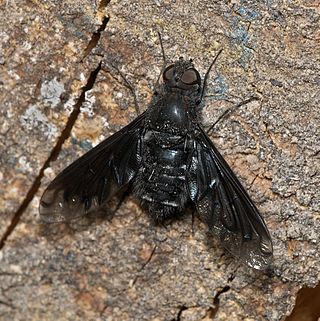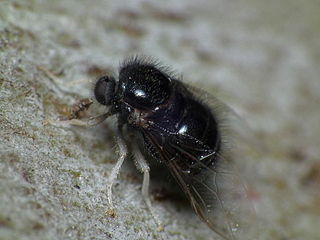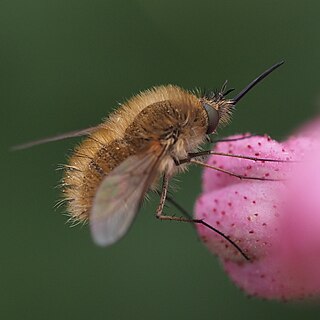
The Bombyliidae are a family of flies, commonly known as bee flies. Adults generally feed on nectar and pollen, some being important pollinators. Larvae are mostly parasitoids of other insects.

Anthrax is a genus of bombyliid flies, commonly known as "bee-flies" due to their resemblance to bees. Most are dull black flies, and are usually small to medium in size, 4–20 millimetres (0.2–0.8 in), and many species have striking wing patterns.

The Asiloidea comprise a very large superfamily insects in the order Diptera, the true flies. It has a cosmopolitan distribution, occurring worldwide. It includes the family Bombyliidae, the bee flies, which are parasitoids, and the Asilidae, the robber flies, which are predators of other insects.

The Acroceridae are a small family of odd-looking flies. They have a hump-backed appearance with a strikingly small head, generally with a long proboscis for accessing nectar. They are rare and not widely known. The most frequently applied common names are small-headed flies or hunch-back flies. Many are bee or wasp mimics. Because they are parasitoids of spiders, they also are sometimes known as spider flies.

Bombylius major is a parasitic bee mimic fly. B. major is the most common type of fly within the Bombylius genus. The fly derives its name from its close resemblance to bumblebees and are often mistaken for them.

Villa is a genus of flies belonging to the bee-fly family (Bombyliidae). They range in size from 5 to 17 millimetres, and have typically rounded heads. The males of some species have a brilliant mat of silvery patagial scales. About 270 Villa species are found on all continents except Antarctica. They can be distinguished from similar genera (Hemipenthes) by their wing venation.

Balaana is a genus of flies belonging to the family Bombyliidae (bee-flies). There are about seven described species, including three from western Australia. These are robust and very hairy flies with a body length of 10–18 mm (0.4–0.7 in).

Anthrax anthrax is a species of fly in the family Bombyliidae. Unlike, for example, Bombylius major, this species does not mimic a bee. The eggs are flicked by the adult female toward the entrance of the nests of mason bees. After hatching, the larvae find their way into the nests to feed on the bee larva. A. can be found in May to August throughout mainland Europe. In the Netherlands A. anthrax is a common visitor of insect hotels. It was first recorded as breeding in Britain in 2019.

Villa modesta is a species of fly in the family Bombyliidae. The larvae may feed on larvae of Lepidoptera.

Bombylius canescens, commonly known as the western bee-fly, is a species of bee-fly belonging to the family Bombyliidae.

Anthracinae is a subfamily of bee flies in the family Bombyliidae. There are more than 80 genera and 2,000 described species in Anthracinae.

Toxophorinae is a subfamily of bee flies in the family Bombyliidae. There are about 7 genera and more than 400 described species in Toxophorinae.

Eclimini is a tribe of bee flies in the family Bombyliidae. This tribe was formerly considered a subfamily of Bombyliidae, but was transferred to the subfamily Bombyliinae as a result of research published in 2019.

Brachyanax is a genus of bee fly in the subfamily Anthracinae. It was circumscribed by Neal Evenhuis in 1981. Thirteen species are recognized, and they are found in Asia and Australasia.

Geminaria is a genus of bee flies.

Phthiria vagans is a species of 'bee flies' belonging to the family Bombyliidae.

Thyridanthrax fenestratus is a Palearctic species of bee fly in the family Bombyliidae. It is found throughout Europe, through Greece and Turkey, Azerbaijan, Tajikistan and across the Palearctic to China in the East

Villa cingulata is a Palearctic species of bee fly in the family Bombyliidae.

Bombylius discolor is a Palearctic species of fly in the family Bombyliidae.

Bombylius minor is a Palearctic species of bee fly in the family Bombyliidae.


















